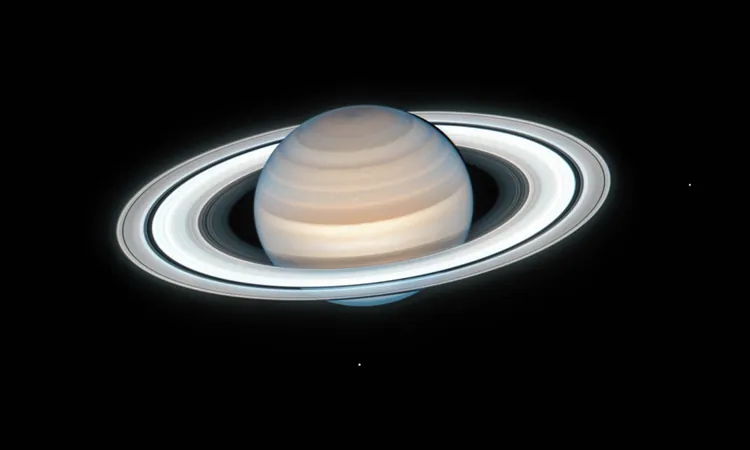
Saturn's Rings Are Disappearing! Find Out When You Can See Them Again!
2025-01-13
Author: Ying
The Mystical Rings of Saturn
Modern telescopes have unveiled Saturn's rings as a stunning collection of ice and rock particles that gracefully orbit the planet. These rings are not merely cosmic ornaments; they offer crucial insights into the gravitational dynamics of our solar system. Researchers, notably Jonah Peter from the Harvard-Smithsonian Center for Astrophysics, are delving into how Saturn's numerous moons influence the behaviors of these ring particles. Through the lens of orbital mechanics, scientists are piecing together the intricate dance of celestial bodies in our cosmic neighborhood.
A Celestial Vanishing Act
Mark your calendars! A captivating event called a "ring plane crossing" is set to occur on **March 23, 2025**. On that date, Saturn’s rings will appear to vanish as they will edge-align with the Earth, transforming our view of the magnificent planet into a mere pale yellow sphere. This celestial phenomenon arises from the natural tilt of Saturn and its location in orbit, leading to a stunning optical illusion.
However, there's no need for despair! This brief disappearance is followed by a return to glory. By **November 2025**, Saturn’s awe-inspiring rings will re-emerge, showcasing their majestic presence once again, alongside glimpses of the planet's many moons.
Anatomy of Saturn's Rings
Saturn's rings are organized into several distinct sections known as the A, B, and C rings, with fainter rings designated D through G. The iconic **Cassini Division**, a notable gap between the A and B rings, highlights the dynamic gravitational interactions at play. These rings are not solid; they consist of countless particles ranging from tiny dust grains to massive chunks the size of buses.
Scientists speculate that these spectacular rings may have originated from a moon torn apart by Saturn’s powerful gravity, or perhaps they are remnants from the planet's initial formation over 4 billion years ago.
Saturn's Moons and Their Role
Saturn boasts at least **145 moons**, each contributing to the maintenance of the rings. Some, known as shepherd moons, help keep the ring particles in line, creating those distinctive gaps and features we admire. Among them, Titan stands out not just for its size but for its complex atmosphere, primarily made of nitrogen, and intriguing geological activity.
The Future of Exploration: Titan and Enceladus
Exciting missions are underway to explore these moons further. NASA’s upcoming **Dragonfly mission** aims to send a flying robotic craft to Titan, aiming to uncover the secrets of its liquid hydrocarbon lakes and thick haze.
Moreover, Enceladus, another intriguing moon, has shown signs that could hint at the possibility of life. Its icy plumes containing water vapor and organic molecules position it as a prime candidate in the search for extraterrestrial life. Jonah Peter notes that Enceladus presents not just conditions necessary for life, but also potential pathways for the formation of complex biomolecules.
Embracing the Wonders of Saturn
As we look forward to witnessing the return of Saturn’s stunning rings, the marvel of this gaseous giant continues to inspire scientists and star gazers alike. Each transition, including this temporary veiling of its rings, invites us to appreciate the constant motion and fluidity of our universe.
Saturn remains a testament to the wonders of space, reminding us that every celestial body holds secrets waiting to be uncovered. Keep your telescopes ready for this lascivious celestial show — the universe has plenty more in store!




 Brasil (PT)
Brasil (PT)
 Canada (EN)
Canada (EN)
 Chile (ES)
Chile (ES)
 Česko (CS)
Česko (CS)
 대한민국 (KO)
대한민국 (KO)
 España (ES)
España (ES)
 France (FR)
France (FR)
 Hong Kong (EN)
Hong Kong (EN)
 Italia (IT)
Italia (IT)
 日本 (JA)
日本 (JA)
 Magyarország (HU)
Magyarország (HU)
 Norge (NO)
Norge (NO)
 Polska (PL)
Polska (PL)
 Schweiz (DE)
Schweiz (DE)
 Singapore (EN)
Singapore (EN)
 Sverige (SV)
Sverige (SV)
 Suomi (FI)
Suomi (FI)
 Türkiye (TR)
Türkiye (TR)
 الإمارات العربية المتحدة (AR)
الإمارات العربية المتحدة (AR)